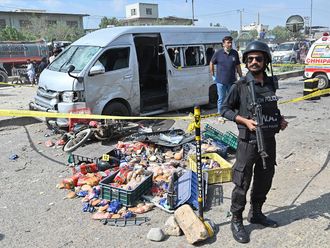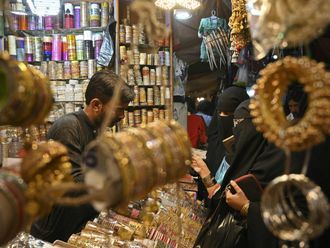Islamabad: With another massive deluge looming in the northern region of Kashmir, Gilgit and Baltistan, three of the country's best known archaeological locations face a high risk of flooding.
Out of six World Heritage Sites in Pakistan, remains of 3rd millennium BC-old Mohenjo-Daro along the river Indus, the Buddhist monastic complex of Takht-i-Bahi in Swat region and 14th century remains of Thatta have been vulnerable to the ongoing "super floods" across Pakistan with southern Sindh province bearing the brunt of the floods.
Irina Bokova of United Nations Educational, Scientific and Cultural Organisation (Unesco) is holding a special meeting in Paris today to discuss the ongoing situation.
Dr Warren Mellor, Unesco Director and Representative in Pakistan, confirmed that the high level meeting, chaired by Bokova and attended by Assistant Director General for Culture, will be focusing on mobilising additional personnel and technical resources for the calamity-hit country.
"Of the three high-risk sites, the ruins of the huge city of Mohenjo-Daro remain the most vulnerable due to soil conditions and the high water table in the area near the raging River Indus," he told Gulf News in Islamabad.
Mohenjo-Daro was built entirely of unbaked brick in the 3rd millennium BC. "The acropolis, set on high embankments, the ramparts, and the lower town, which is laid out according to strict rules, provide evidence of an early system of town planning," reads Unesco World Heritage Site's brief about the ancient location.
Damage
The Unesco team is waiting to rush for assessment of damage as soon as the water recedes and the emergency phase is over, said the Unesco country representative.
Dr Mellor, however, said there was no substantive damage so far that Unesco is aware of. Local residents in Swat region report that heavy rains and flooding have caused some damage to the Buddhist monastic complex of Takht-i-Bahi (Throne of Origins), founded in the early first century.
Well-preserved
Though owing to its location on the crest of a high hill, it escaped successive invasions and remains exceptionally well-preserved, eye witnesses report some damage.
However, no experts are ready to comment or authenticate any such random assessment. The ruins of Sahr-i-Bahlol, a small fortified city dating from the same period, are also located in the same area.
Thatta, the southern city of Sindh, capital of three successive dynasties and later ruled by the Mughal emperors of Delhi, dates back from the 14th to the 18th century. The remains of the city and its necropolis provide a unique view of Sindh civilisation.
Unesco is concerned about the issue of culture and cultural livelihood, such as the artifacts, which "females prepare indoors that not only become sources of livelihood but also a way of preservation of the local heritage," said Dr Mellor.
About month-long monsoon rains have so far affected 20 million people in Pakistan, costing over $4 billion (Dh14.68 billion) according to conservative estimates.
Food crisis looms
The United Nations warns that unless farmers in hard-hit Punjab and Sindh provinces manage to plant their winter crop of wheat in mid-September as normal, there might be food shortages in the region and the nation as a whole.
In the north, where the floods began nearly three weeks ago, fruit farmers are also hurting.
Last year, cherries, peaches and apricots in the Swat Valley rotted on the trees because of an army operation against Taliban militants. This year, roads and bridges have been washed away so crops cannot be carried to the rest of the country.
With input from AP












